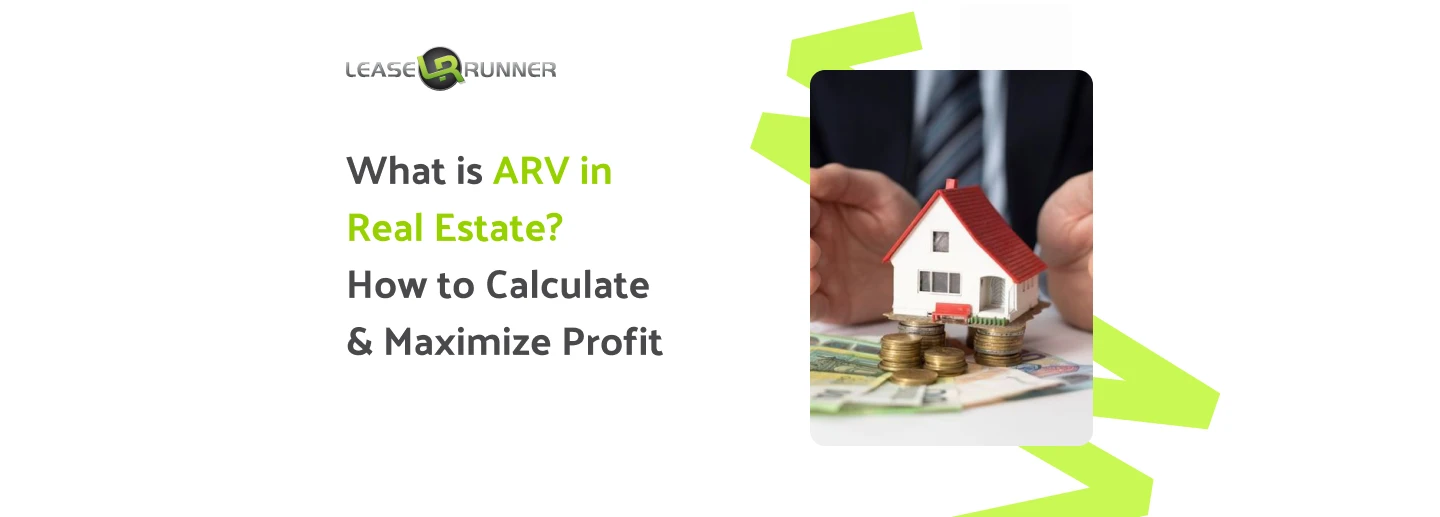
Every real estate investor wants to maximize returns, and ARV (After-Repair Value) is a powerful tool for doing just that. ARV represents a property's estimated value after renovations, guiding investors on purchase prices, rehab budgets, and potential profits. In this article, we’ll explain ARV in real estate and explain how to use it to make smarter decisions.
After-Repair Value (ARV) in Real Estate: Definition & Calculation

After-Repair Value (ARV) is an essential metric in real estate investing that estimates the market value of a property after all planned repairs, renovations, or improvements are completed. It helps investors assess potential profitability and make informed buying or financing decisions.
To put it simply, this calculation helps investors determine how much to pay for a property, how much to spend on repairs, and the potential profit margin when selling or renting it out. Investors must also ensure that their renovations and marketing strategies comply with the Fair Housing Act, which prohibits discrimination in housing based on race, color, national origin, religion, sex, familial status, or disability.
For landlords, ARV helps determine whether the property will generate enough rental income to justify the investment. It is typically estimated by analyzing comparable sales (comps) of similar renovated homes in the same area.
How to Calculate ARV in the Real Estate Sector?
So, how to determine ARV? Calculating ARV involves two main steps:
- Assessing Comparable Sales (Comps) – Find recently sold properties in the same neighborhood with similar characteristics (size, age, condition) that have already been renovated. These provide a benchmark for estimating the property's post-repair ARV value.
- Using the ARV Formula
ARV = Purchase Price + Renovation Costs
Or more commonly: ARV = Market Value of Comparable Properties
For example, suppose similar renovated homes in the area are selling for $300,000, and you purchase a property for $200,000 with plans to invest $50,000 in renovations. In that case, the ARV is estimated at $300,000, based on comparable sales—not $200,000 + $50,000.
What is the 70% Rule in Real Estate Investing?
The 70% Rule is a vital formula in real estate investing, especially for house flippers. It states that an investor should pay no more than 70% of the after-repair value (ARV) of a property, minus the estimated repair costs.
Maximum Offer Price = (ARV × 70%) − Repair Costs
For example, if a property's ARV is $300,000, and it needs $50,000 in repairs, the maximum price an investor should pay is:
($300,000 × 70%) − $50,000 = $210,000 − $50,000 = $160,000
Ultimately, the 70% Rule is a useful starting point. Still, experienced investors adjust based on real-world factors, such as market conditions, property location, and an investor’s strategy can influence the actual purchase price.
How Does This Apply to Rental Property Owners?
For rental property owners, the After-Repair Value (ARV) is just as important as it is for house flippers, although it serves a different purpose. While house flippers use ARV to determine a property’s resale price, landlords use it to evaluate whether the property's value and potential rental income justify the purchase and renovation costs.
- Determining Cash Flow & ROI: If a rental property is undervalued but requires repairs, calculating ARV helps investors estimate its post-renovation rental value and potential return on investment (ROI). A property’s ARV should align with market rents and projected long-term value appreciation.
- Financing & Refinancing: Many landlords use the BRRRR strategy (Buy, Rehab, Rent, Refinance, Repeat) to grow their portfolio. Lenders often consider ARV when determining loan terms and refinance options but also factor in rental income, debt-to-income ratio, and creditworthiness.
- Setting Competitive Rents: Renovating a property with ARV in mind allows landlords to justify higher rental rates by enhancing the property's appeal, attracting reliable tenants who value quality living spaces and are willing to pay competitive market rents. If a landlord invests wisely in upgrades that boost the ARV—such as modern kitchens, updated bathrooms, and energy-efficient features—the property with potential can command higher rental income.
- Increasing Long-Term Appreciation: A high ARV indicates strong future resale value, which benefits buy-and-hold investors. Rental properties with solid ARVs can appreciate over time, allowing owners to build wealth through both rental income and equity growth.
Tip: To ensure you secure responsible renters who can meet payment expectations, consider implementing a thorough tenant screening process before leasing your property.
Where to Find ARV Data Without Overpaying for Reports?

Getting accurate ARV data doesn’t have to mean shelling out hundreds of dollars for expensive reports. Smart investors know where to look for reliable, cost-effective (or even free) sources of ARV value information.
- Use Free Real Estate Websites: Platforms like Zillow, Redfin, and Realtor.com offer valuable sales history, price trends, and comparable property with potential data (free ARV calculator by address).
- Leverage MLS (Multiple Listing Service) Data: If you have access to MLS (or work with an agent who does), you’ll get the most up-to-date sales data on renovated properties. The MLS includes detailed property descriptions, sold prices, and high-quality photos.
- Network with Local Real Estate Experts: Real estate agents, appraisers, and investors in your area are goldmines of ARV insights. They often know about off-market sales and upcoming trends that aren’t yet reflected in public listings. A quick conversation with an experienced investor can sometimes be more valuable than a paid report.
- Pull County Tax Records & Public Sales Data: Many counties provide free property sales history and tax assessments online. While these won’t always reflect after-repair values, they help establish a baseline for property appreciation trends.
Common Mistakes When Estimating ARV (and How to Avoid Them)
Even seasoned investors can get ARV calculations wrong, leading to bad deals and lost profits. Let’s learn how to avoid these common mistakes!
- Comparing the Wrong Properties: Not all homes in a neighborhood are true “comps.” Comparing a fully renovated home to one with outdated features will give you misleading numbers. Stick to homes with similar sizes, conditions, layouts, and upgrades for the most accurate ARV estimate.
- Overlooking Renovation Costs: Underestimating repair expenses is a profit killer. Always get contractor estimates upfront and build in a contingency budget (typically 10-20%) for unexpected issues.
- Ignoring Market Trends: ARV fluctuates based on market conditions. A hot market today could cool down in six months. Stay updated on local price trends, inventory levels, and demand.
- Forgetting Holding & Selling Costs: Many investors focus only on purchase price and rehab costs but don’t forget about closing costs, agent commissions, property taxes, insurance, and loan interest. These can eat into your profit margin if not factored into the ARV calculation.
- Relying Too Much on Online Estimates: Automated tools like Zillow’s Zestimate are helpful but not 100% accurate. Always verify ARV using multiple sources before making an investment decision.
ARV vs. Market Value vs. Discount to ARV: A Comparison
Real estate investing requires a solid understanding of key valuation metrics: ARV, market value, and discount to ARV.
How ARV Helps Real Estate Investors Make Smart Decisions

Sometimes, ARV can be a powerful decision-making tool!
For Fix-and-Flip Investments
Flippers live and die by ARV. A smart fix-and-flip investor will:
- Use ARV to set a maximum purchase price (following the 70% Rule)
- Plan renovations strategically to boost ARV without overspending
- Analyze market conditions to time the sale for maximum profit
For example, if ARV is $350,000, and the investor follows the 70% Rule, they should aim to buy the property for no more than $195,000 (after factoring in renovation costs).
For Buy-and-Hold Strategies
Long-term investors use ARV to assess rental property appreciation and refinance opportunities. It helps:
- Determining post-rehab rental income – A high ARV often leads to higher rental rates.
- Securing better loan terms – Lenders may offer larger loans based on ARV.
- Building long-term equity – Investors can leverage a high ARV to refinance and purchase additional properties.
For Securing Loans
Lenders rely on ARV to assess loan eligibility and determine how much they’re willing to finance. This is especially true for:
- Hard money lenders – typically lend based on a percentage of ARV (e.g., 70-75%).
- BRRRR investors – Use ARV to refinance and pull out cash for future deals.
- Traditional mortgage lenders – Assess post-rehab property value before issuing a loan.
Final Thoughts
Overall, when used correctly, ARV empowers real estate investors to make well-informed decisions and achieve greater profitability. As you continue your investing journey, don’t forget to factor in the nuances of ARV in your strategy. For more expert advice, resources about “What is ARV in real estate?”, and rental management solutions, LeaseRunner has everything you need to simplify your rental experience!
FAQs
Q1: How do I find the ARV of a house?
To find the ARV of a house, start by searching for recently sold, renovated properties in the same neighborhood. Use tools like Zillow, Redfin, and Realtor.com to find comparable homes. Then, average the sale prices of the comps and apply this information to estimate the ARV of the house.
Q2: How do I estimate repair costs on a rehab?
Estimating repair costs starts by hiring a contractor to assess the property. They’ll provide a detailed estimate based on the scope of work needed. Next, break down the repairs into categories like plumbing, electrical, and flooring. Estimate costs for each category based on average local prices. You can also use online rehab calculators to get an idea of typical costs. And always add a contingency of 10-20% for unexpected repairs.




